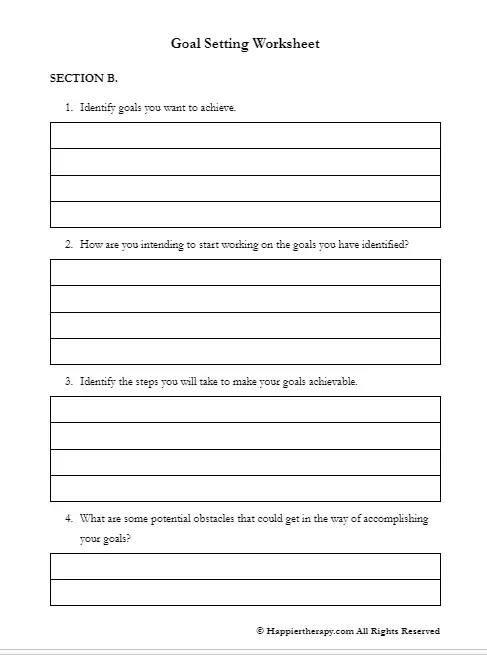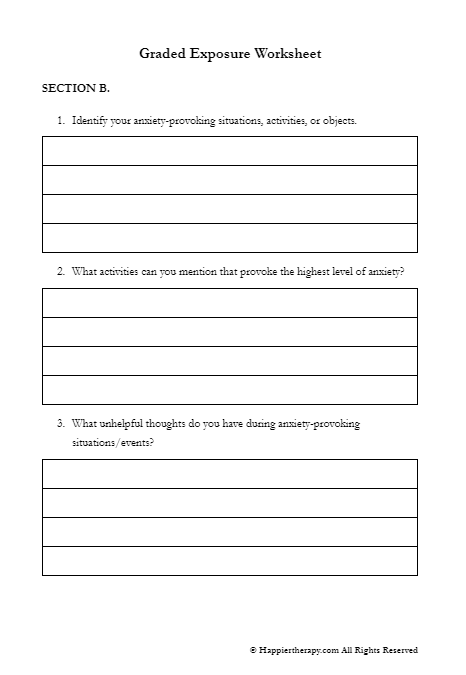Clinical therapy worksheets
Premium Content
Access this worksheet and 2,500 mental health worksheets. Cancel anytime
What is the theory behind these clinical therapy worksheets?
Clinical therapy worksheets generally refer to a set of tools and activities used by therapists to help clients understand and work through their problems. The theory behind these worksheets varies depending on the specific type of therapy being used.
Unlock deeper healing — upgrade to Premium now!
Customizable and fillable worksheets
Rights to alter the worksheets
Over 2000 worksheets
Support HappierTherapy
- Cognitive-behavioral therapy (CBT) is a type of therapy that is based on the idea that thoughts, feelings, and behaviors are interconnected and that changing negative thoughts and behaviors can improve mental health. CBT worksheets can be used to help clients identify and challenge negative thoughts, set goals, and track progress.
- Dialectical Behavior Therapy (DBT) is a type of therapy that combines cognitive-behavioral techniques with mindfulness and acceptance strategies. DBT worksheets can be used to help clients identify and regulate emotions, improve relationships, and develop coping skills.
- Humanistic therapy is a type of therapy that focuses on understanding the whole person and promoting self-awareness and personal growth. Humanistic therapy worksheets can be used to help clients explore their values, beliefs, and goals, and to identify areas of their lives that they would like to change.
Overall, clinical therapy worksheets are based on different psychological theories and they provide a structured format for clients to work through their problems and make positive changes in their lives.
How will the worksheet help?
Clinical therapy worksheets can help clients in a number of ways depending on the type of therapy being used:
- CBT worksheets can help clients to identify and challenge negative thoughts and beliefs that are contributing to their problems. By providing a structured format for clients to identify and track their thoughts, feelings, and behaviors, worksheets can help clients to see patterns and make connections that they may not have noticed before. This can help clients to understand the underlying causes of their problems and develop strategies for addressing them.
- DBT worksheets can help clients to identify and regulate their emotions and improve their relationships. By providing exercises and activities that focus on mindfulness and acceptance, worksheets can help clients to develop a more balanced perspective on their problems and to develop coping skills that will help them to manage difficult situations more effectively.
- Humanistic therapy worksheets can help clients to explore their values, beliefs, and goals, and to identify areas of their lives that they would like to change. By providing a structured format for clients to reflect on their lives and the things that are important to them, worksheets can help clients to gain a deeper understanding of themselves and to set goals that are meaningful and achievable.
Overall, therapy worksheets can help clients to better understand and work through their problems, and make positive changes in their lives. They also provide a reference point for clients to track their progress and measure the effectiveness of their therapy sessions.
How to use the worksheet?
Using a clinical therapy worksheet typically involves the following steps, depending on the type of therapy being used:
- CBT: Before using the worksheet, the therapist will introduce the concept of cognitive-behavioral therapy and explain how negative thoughts, feelings, and behaviors are interconnected. During a therapy session, the therapist and the client will work together to identify negative thoughts and beliefs that are contributing to the client’s problems. The client will complete the worksheet by recording these thoughts and beliefs, and identifying the evidence for and against them.
- DBT: Before using the worksheet, the therapist will introduce the concept of dialectical behavior therapy and explain how to regulate emotions and improve relationships. During therapy session, the client will complete the worksheet by identifying and rating their emotions, and the situations that triggered them. They will also practice mindfulness and acceptance exercises, and develop coping skills for dealing with difficult situations.
- Humanistic therapy: Before using the worksheet, the therapist will introduce the concept of humanistic therapy and explain how it can help clients to gain a deeper understanding of themselves and set goals. During therapy sessions, the client will complete the worksheet by reflecting on their values, beliefs, and goals, and identifying areas of their lives that they would like to change.
- After completing the worksheet, the therapist will review the answers with the client, and discuss the main concepts. The therapist will encourage the client to reflect on how the worksheet relates to their problems and how it can help them to make positive changes in their lives.
Was this helpful?
References
1.-
(2022, June 21). Psychology Tools. https://www.psychologytools.com/
2.-
Ackerman., C. E. (2019, May 28). 17 therapy worksheets for teens, adults, and couples (+PDFs). PositivePsychology.com. https://positivepsychology.com/therapy-worksheets/

 By
By


